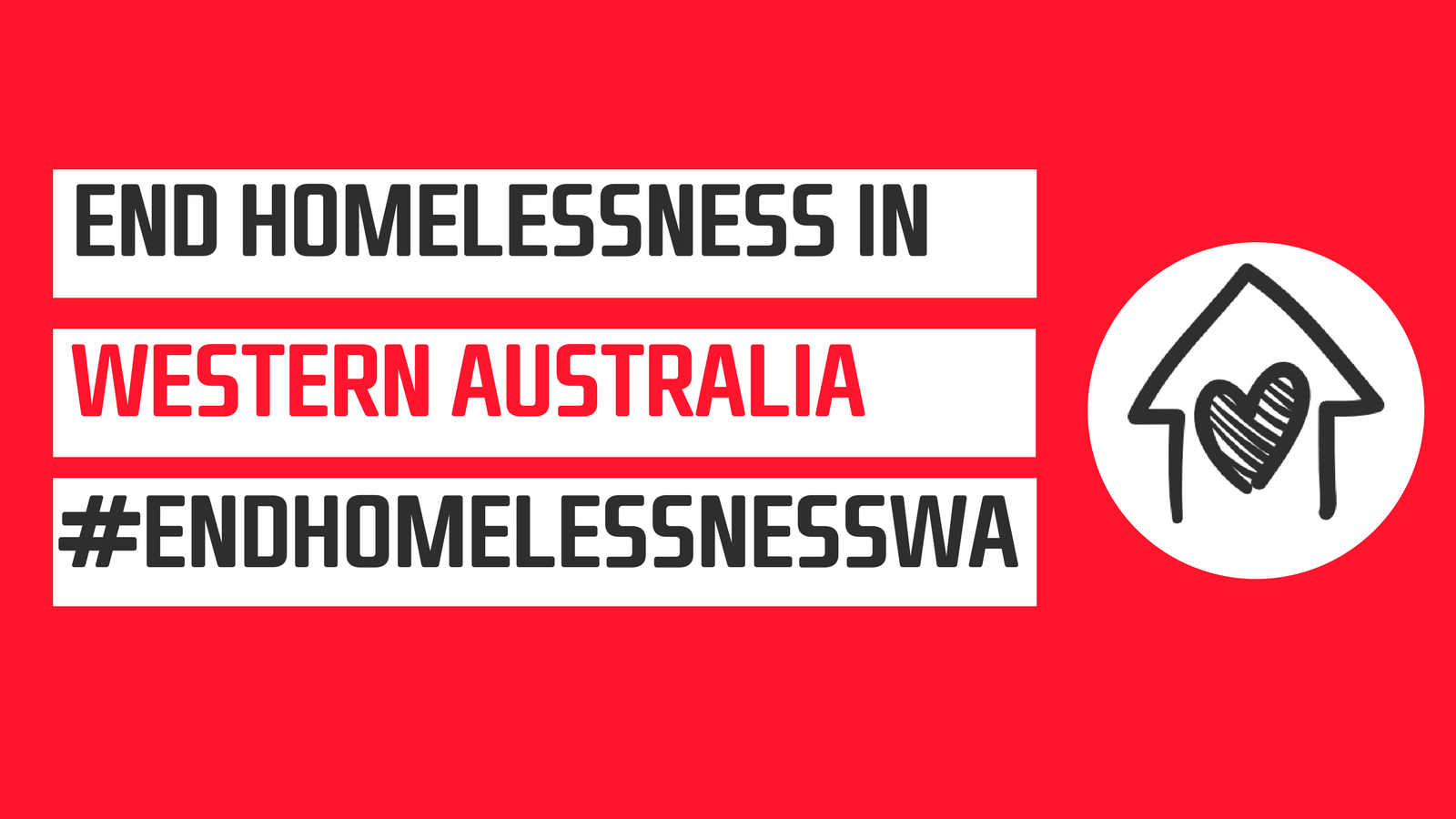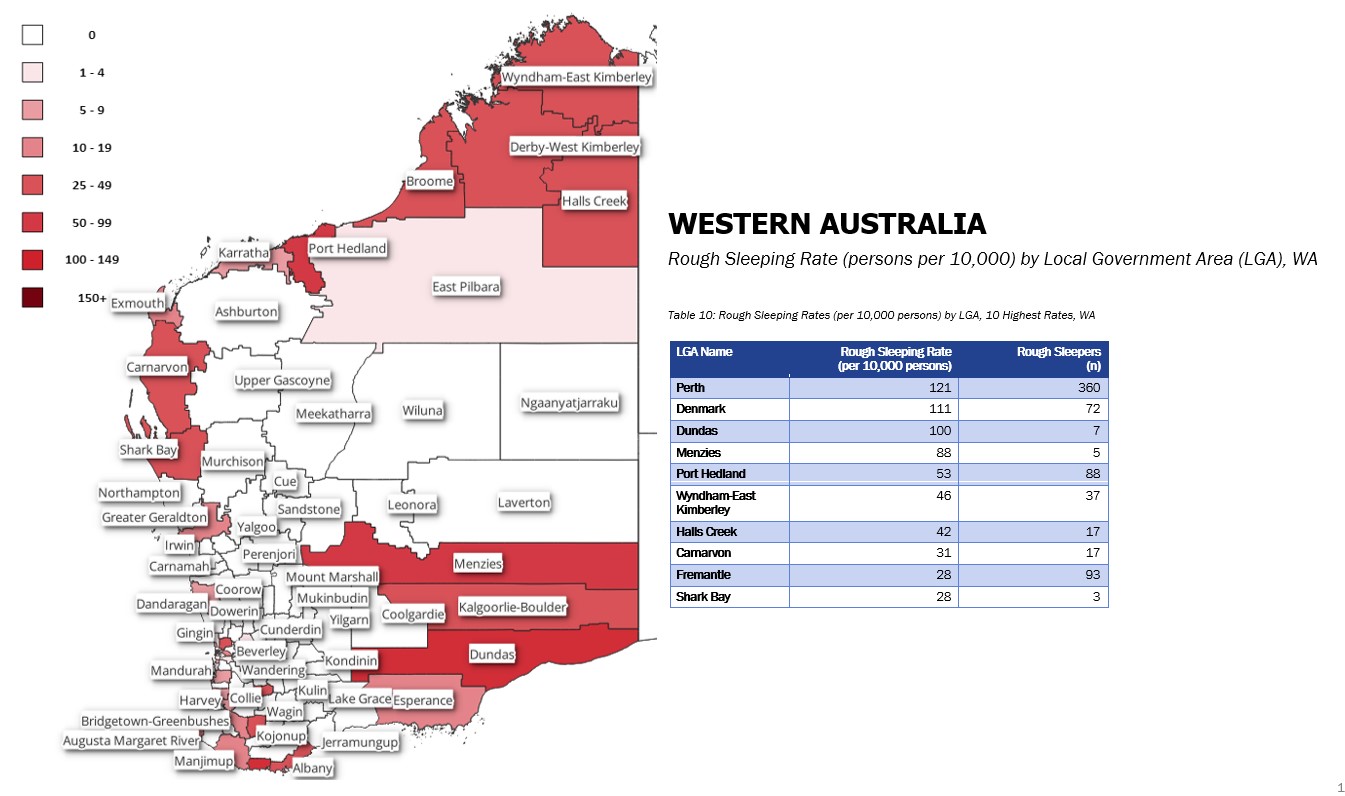Western Australian Alliance to End Homelessness Dashboard |

|
Ending chronic homelessness in WA
Target 1
Western Australia will have ended all forms of persistent homelessness including persistent rough sleeping
For the purposes of the WAAEH Dashboard, persistent homelessness is defined as a history of rough sleeping or other forms of homelessness for more than 12 months continuously. There are limited data available that measure persistency in homelessness. Our data are from the Advance to Zero national database and were collected using the Vulnerability Index Service Prioritisation Decision Assistance Tool (VI-SPDAT).
We looked at persistent homelessness in WA which we defined as an answer of more than 12 months to the question: For how many months have you lived on the streets or in emergency accommodation?
From 1 January 2016 to 30 June 2022, the proportion of respondents exhibiting persistent homelessness varied from 56% to 69%. The peak in the proportion of respondents exhibiting persistent homelessness during 2020 may have been impacted by the effects of COVID-19 and may reflect an increase in the proportion of those persistently homeless in the overall homeless community (Figure 1.1).
The rates of access to SHS reflect the nature of the service system, including the availability and accessibility of services and the types of supports provided. The SHS data indicates that, relative to national rates, Western Australians accessing SHS do so for much shorter support periods and are accommodated for far fewer nights. In 2021-22, the median length of support received was 22 days in Western Australia and 53 days nationally.
2020/21 | 2021/22 | |||
|---|---|---|---|---|
Support |
Western Australia |
Australia |
Western Australia |
Australia |
Median length of support (days) |
22 |
51 |
22 |
53 |
Median length of accommodation (nights) |
8 |
31 |
8 |
32 |
|
|
||||
Target 2
No individual or family in Western Australia will sleep rough or stay in supported accommodation for longer than five nights before moving into an affordable, safe, decent, permanent home with the support required to sustain it
Target 2 requires further research before full operationalisation. Both the Australian Institute of Health and Welfare Specialist Homelessness Services Collection (SHSC) data and the Registry Week surveys administered by the AAEH Advance to Zero campaign can produce proxy measures to estimate how well we are approaching this target. The VI-SPDAT questionnaire administered during Registry Week by the AAEH collects information on individual and family housing situations (including sleeping rough or staying in supported accommodation). This could be combined with the responses to the following question, which asks ‘How long has it been since you lived in permanent, stable housing (with a secure lease/tenancy)?’ to determine the number of individuals or families who are sleeping rough or staying in supported accommodation for longer than five nights. Additionally, SHSC records include data on the number of nights clients spend in supported accommodation. While this does not include rough sleeping, the percentage of SHS clients spending more than five nights in supported accommodation could be a useful measure for this target.
Reducing the rate of homelessness in WA
Target 3
The Western Australian rate of homelessness (including couch surfing and insecure tenure) will have been halved from its 2016 level
Reducing the overall rate of homelessness
In 2016, 36.4 per 10,000 Western Australians were homeless according to the Census. To achieve the target of halving the rate of homelessness by 2028, this rate will need to decrease to 18.2 persons per 10,000. However, in the 2021 census, the homelessness rate rose to 38.6 per 10,000. (Figure 3.1).
In 2017/18 and 2018/19 the homeless rate as recorded by the Specialist Homelessness Service Collection decreased slightly to 32.5 and 32.6 respectively, before increasing to 34.8 in 2019/20 and dropped to 32.5 in 2020/21, above the trajectory for the target of 17.2 persons per 10,000 by 2028 (Figure 3.2).
There was a drop in both clients who were homeless and clients at risk of homelessness accessing SHS in April 2020, coinciding with the outbreak of the COVID-19 pandemic and likely attributed to nation-wide lockdown measures which resulted in many services cutting back direct service delivery for a period. By December 2020, the numbers of both client groups increase to approximately pre-pandemic levels and a further increase in the following years occurs, to the highest level in March 2023 (the latest monthly data we have). The monthly series also shows that among male clients, a higher proportion are homeless compared to female clients, while the opposite trend is seen in clients at risk of homelessness (Figures 3.3 and 3.4).
In the case of those experiencing homelessness on entry to support to SHS services, the majority completed their support period in the same homelessness position that they began their support period in. In other words, the majority started and ended their support period still homeless and in the same homelessness position (e.g., those rough sleeping in the beginning of the support period remained rough sleeping at the end. There was a slight reduction from the previous period in positive transitions from homelessness to both social housing (15% in 2021 to 14% in 2022) and private rental housing (13% in 2021 to 10% in 2022). (Figure 3.6).
In the case of those at risk of homelessness, the very low proportion of clients that move from housing to homelessness and remain in the same permanent housing state is a very positive outcome, showing that the vast majority of SHS clients at risk of homelessness at the beginning of the support period remained housed through their support period (Figure 3.7).
Reducing Aboriginal homelessness
Target 5
The Western Australian rate of homelessness (including couch surfing and insecure tenure) will have halved from its 2016 level. The current very large gap between the rate of Aboriginal homelessness and non-Aboriginal homelessness in Western Australia will be eliminated so that the rate of Aboriginal homelessness is no higher than the rate of non-Aboriginal homelessness.
Reducing Aboriginal homelessness
There is a significant over-representation of Aboriginal and Torres Strait Islander people in the Western Australian homeless population. While making up only 3.3% of the general population, Aboriginal and Torres Strait Islanders represented 35% of the homeless population at the 2021 Census (ABS, 2021). Between 2011 and 2016, there was a substantial decrease in the overall rate of Aboriginal and/or Torres Strait Islander homelessness. However, the Indigenous homelessness rate increased in 2021, from 344.6 persons per 10,000 to 380.5 persons per 10,000. This rate of increase needs to not only be reversed, but dramatically decreased to achieve the goal of eliminating the over-representation of Aboriginal and/or Torres Strait Islander homelessness in WA. (Figure 5.1).
The rate of Aboriginal and/or Torres Strait Islander homelessness living in improvised dwellings, tents or sleeping out drastically increased from 2016 to 2021, from 48.8 per 10,000 to 148.1 per 10,000. Since this is reflective of the most extreme form of homelessness, an even stronger focus will need to be put into improving the ability of Aboriginal and/or Torres Strait Islander people within this category to exit it (Figure 5.2).
Reducing regional homelessness
The proportion of SHS clients that live in regional Western Australia has slightly decreased in 2021/22 (51.0%) compared to 2020/21 (53.2%). The 2028 target for Figure 5.6 is to eliminate this over-representation, such that the rate of regional homelessness is the same as the rate of people living in regional WA (20.6%).
In the 2021 Census nine out of ten of the highest homelessness rate Local Government Areas (LGA) were in non-metropolitan Perth, while 8 out of 10 of the highest rough sleeping rate LGAs were in non-metropolitan Perth.


Addressing the needs of those experiencing homelessness
Target 6
Those experiencing homelessness and those exiting homelessness with physical health, mental health, and alcohol and other drug use dependence needs will have their needs addressed. This will result in a halving of mortality rates among those who have experienced homelessness and a halving in public hospital costs one year on for those exiting homelessness
Figure 6.1 demonstrates that there has been a large decline in the 2020/21 period – which saw only 40.1% of all individuals accessing Specialist Homelessness Services ending their support periods with their immediate needs and goals met. This is below projected targets, indicating a need for greater and sustained focus on understanding and addressing the complex needs of Specialist Homelessness Services clients.
